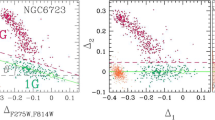Abstract.
We present a formation scenario for metal-poor globular cluster systems. We assume old metal-poor globular clusters are formed only prior to reionization (at \(z \sim 7\)) in merging proto-galactic building blocks; the building blocks assemble hierarchically into larger structures such as galaxies. We additionally assume that globular cluster formation is suppressed immediately after reionization: subsequent globular cluster formation results in a gap in the metallicity distributions of globular cluster systems. We describe generic predictions of the model with regard to the “blue specific frequency problem” and the spatial distribution of metal-poor globular cluster systems. We conclude with a discussion of the range of applications for this model.
Preview
Unable to display preview. Download preview PDF.
Similar content being viewed by others
Author information
Authors and Affiliations
Editor information
Rights and permissions
About this paper
Cite this paper
Santos, M.R. The High-Redshift Formation of Metal-Poor Globular Cluster Systems. In: Kissler-Patig, M. (eds) Extragalactic Globular Cluster Systems. ESO ASTROPHYSICS SYMPOSIA. Springer, Berlin, Heidelberg. https://doi.org/10.1007/10857603_53
Download citation
DOI: https://doi.org/10.1007/10857603_53
Published:
Publisher Name: Springer, Berlin, Heidelberg
Print ISBN: 978-3-540-40472-9
Online ISBN: 978-3-540-45044-3
eBook Packages: Springer Book Archive




